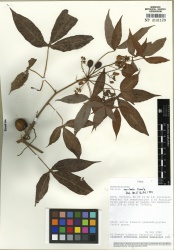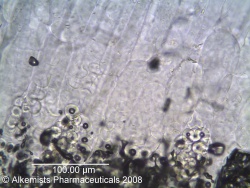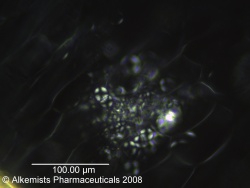Manihot esculenta (root)
From AHPA Botanical Identity References Compendium
(Difference between revisions)
(add askbox) |
(add USD 1918 information (macroscopic/microscopic)) |
||
| Line 27: | Line 27: | ||
=Macroscopic Characteristics= | =Macroscopic Characteristics= | ||
| + | {| border=1 | ||
| + | | | ||
| + | {{Macroscopy | source=United States Dispensatory (1918) | ||
| + | | description=Tapioca is in irregular, hard, white, rough grains, possessing little taste, partially soluble in cold water, and affording a fine blue color when iodine is added to its filtered solution. The partial solubility in cold water is owing to the rupture of the starch granules by heat. }} | ||
| + | |} | ||
| + | |||
=Microscopic Characteristics= | =Microscopic Characteristics= | ||
| + | {| border=1 | ||
| + | | | ||
| + | {{Macroscopy | source=United States Dispensatory (1918) | ||
| + | | description=Examined under the microscope, the granules appear somewhat plano-convex or bell-shaped and more or less compound. The individual grains vary from 0.006 to 0.030 mm. in diameter and have a distinct central circular or radiating cleft. They polarize light strongly, showing a distinct cross. }} | ||
{{Media2 |cat=Microscopy | source=Elan M. Sudberg, Alkemist Laboratories | {{Media2 |cat=Microscopy | source=Elan M. Sudberg, Alkemist Laboratories | ||
| Line 41: | Line 51: | ||
| reference=Powdered Vegetable Drugs, Jackson, B., 1968 | | reference=Powdered Vegetable Drugs, Jackson, B., 1968 | ||
| }} | | }} | ||
| − | + | |} | |
=High Performance Thin Layer Chromatographic Identification= | =High Performance Thin Layer Chromatographic Identification= | ||
Revision as of 18:27, 31 March 2015
Contents |
Nomenclature
Manihot esculenta Crantz Euphorbiaceae
Syn. Janipha manihot (L.) Kunth; Jatropha manihot L.
Standardized common name (English): cassava
Botanical Voucher Specimen
|
|
Organoleptic Characteristics
Macroscopic Characteristics
|
Microscopic Characteristics
|
High Performance Thin Layer Chromatographic Identification
Supplementary Information
Sources
- ↑ MOBOT, Tropicos.org http://www.tropicos.org/Image/100000722
- ↑ United States Dispensatory (1918)
- ↑ United States Dispensatory (1918)
- ↑ Elan M. Sudberg, Alkemist Laboratories http://www.alkemist.com
- ↑ Elan M. Sudberg, Alkemist Laboratories http://www.alkemist.com



